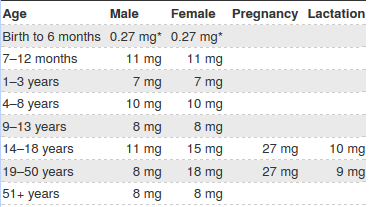Nutrition: Everything about Iron
Do you hear about someone of your friend or family members with anemia?
Iron deficiency is more common in a woman than men. Anemia is a severe health problem, and untreated can lead to depression, pregnancy complications, issues in children's cognitive development, risk of infections, and health problems.
Iron is a mineral naturally found in some food and available in dietary supplements and is an essential component of hemoglobin and erythrocyte (red blood cell transfer oxygen from lungs to tissues). Furthermore, iron supports muscles, connective tissue, neurological development, cellular function, and some hormones.
There are two types of iron.
Heme( from animal sources) and non-heme ( from plant sources)
The big difference between both is that Heme Iron is more easily absorbed. Non Heme iron is more difficult to assimilate by the body.
What are the standard recommendations?
How to Prevent Iron Deficiency
The best advice is to have a balanced diet, including all products in moderation. Try to include high-iron food in your daily meals and reduce animal consumption.
Important Note:
It's not necessary to consume animal products.
Iron absorption can increase by combining iron-rich foods from plants with sources of vitamin C. (Fortified cereal and some berries).
Caffeine products can inhibit the absorption of iron.
Quick Advice
Have moderation in the consumption of red meat.
Eat iron-fortified foods.
Eat more vitamin C foods.
Give at least 1 hour to drink coffee, tea, or any caffeine product.
For more iron absorption, increase food rich in vitamin C (100ml of vitamin c rises 67% of iron absorption).
Increase the consumption of vitamin A and beta-carotene foods.
Foods containing calcium and polyphenols can significantly reduce iron absorption.
Eat foods rich in non-heme iron
Eat more vitamin C foods.
Remember that this information is a suggestion of what many experts and books.
Best sources of iron
RDI: Reference Daily Intake is the daily intake level of a nutrient.
Consume in moderation
Clams or mussels: Provides 155% of the RDI ( Serving portion 3.5-ounce or100-gram)
Oysters: Provides 155% of the RDI ( Serving portion 3.5-ounce or100-gram)
Red Meat ( Consume in Moderation): Provides 15% of the RDI (Serving portion 3.5-ounce 100-gram)
Liver and organ meats (brain, heart, kidneys, and liver): Provides 36% of the RDI ( serving portion 3.5-ounce or 100-gram)
Shellfish: Provides 155% of the RDI ( Serving portion 3.5-ounce or100-gram)
Turkey: Provides 13% of the RDI( serving portion 3.5-ounce or 100-gram)
Plant-based sources
Dark Leafy Greens ( Spinach): Provides 20% of the RDI (Serving portion 3.5 ounces or 100 grams)
Quinoa: provides 15% of the RDI for Iron (Serving portion one cup or185 grams ( cooked) )
Broccoli: Provides 6% of the RDI (Serving portion 1-cup or 156-gram). Also a good source of vitamin C.
Lentils: Provides 37% of the RDI (Serving portion One cup or 198 grams (cooked))
Punking seed: Provides 26% of the RDI (Serving portion 1-ounce or 28-gram )
Tofu: Provides 19% of the RDI for iron per serving( serving portion 126-gram)
Other products
Dark chocolate: One small serving provides 19% of the RDI (1-ounce or 28-gram serving). Make sure it is at least 70% cocoa.
Fortified breakfast cereals
Whole-grain and enriched bread.
Disclaimer
Living your Best Version does not provide Medical Advice. Text, graphics, images, and other materials are for informational purposes only. The Content does not intend to be a substitute for professional medical advice, diagnosis, or treatment. Always seek the advice of your physician or another qualified health provider with any questions you may have regarding a medical condition.
References
Institute of Medicine. Food and Nutrition Board. Dietary Reference Intakes for Vitamin A, Vitamin K, Arsenic, Boron, Chromium, Copper, Iodine, Iron, Manganese, Molybdenum, Nickel, Silicon, Vanadium, and Zinc : a Report of the Panel on Micronutrients. Washington, DC: National Academy Press; 2001.
Drakesmith H, Prentice AM. Hepcidin and the Iron-Infec
Kaufman, Caroline. “Foods to Fight Iron Deficiency.” EatRight, www.eatright.org/health/wellness/preventing-illness/iron-deficiency.
“Mollusks, Clam, Mixed Species, Cooked, Moist Heat Nutrition Facts & Calories.” Nutrition Data Know What You Eat., nutritiondata.self.com/facts/finfish-and-shellfish-products/4182/2.
“Spinach, Cooked, Boiled, Drained, without Salt Nutrition Facts & Calories.” Nutrition Data Know What You Eat., nutritiondata.self.com/facts/vegetables-and-vegetable-products/2627/2.
“Beef, Ground, 85% Lean Meat / 15% Fat, Loaf, Cooked, Baked [Hamburger, Ground Round] Nutrition Facts & Calories.” Nutrition Data Know What You Eat., nutritiondata.self.com/facts/beef-products/6202/2.
“Seeds, Pumpkin and Squash Seed Kernels, Dried [Pepitas] Nutrition Facts & Calories.” Nutrition Data Know What You Eat., nutritiondata.self.com/facts/nut-and-seed-products/3066/2.
“Quinoa, Cooked Nutrition Facts & Calories.” Nutrition Data Know What You Eat., nutritiondata.self.com/facts/cereal-grains-and-pasta/10352/2.
“Turkey, All Classes, Dark Meat, Cooked, Roasted Nutrition Facts & Calories.” Nutrition Data Know What You Eat., nutritiondata.self.com/facts/poultry-products/827/2.
“Broccoli, Cooked, Boiled, Drained, without Salt Nutrition Facts & Calories.” Nutrition Data Know What You Eat., nutritiondata.self.com/facts/vegetables-and-vegetable-products/2357/2.
“Tofu, Raw, Firm, Prepared with Calcium Sulfate Nutrition Facts & Calories.” Nutrition Data Know What You Eat., nutritiondata.self.com/facts/legumes-and-legume-products/4467/2.
“Candies, Chocolate, Dark, 70-85% Cacao Solids Nutrition Facts & Calories.” Nutrition Data Know What You Eat., nutritiondata.self.com/facts/sweets/10638/2.
Morck, T A, et al. “Inhibition of Food Iron Absorption by Coffee.” The American Journal of Clinical Nutrition, U.S. National Library of Medicine, Mar. 1983, www.ncbi.nlm.nih.gov/pubmed/6402915.
García-Casal, M N, et al. “Vitamin A and Beta-Carotene Can Improve Nonheme Iron Absorption from Rice, Wheat and Corn by Humans.” The Journal of Nutrition, U.S. National Library of Medicine, Mar. 1998, www.ncbi.nlm.nih.gov/pubmed/9482776.
Hallberg, L, and L Hulthén. “Prediction of Dietary Iron Absorption: an Algorithm for Calculating Absorption and Bioavailability of Dietary Iron.” The American Journal of Clinical Nutrition, U.S. National Library of Medicine, May 2000, www.ncbi.nlm.nih.gov/pubmed/10799377.
Hallberg, L, and L Hulthén. “Prediction of Dietary Iron Absorption: an Algorithm for Calculating Absorption and Bioavailability of Dietary Iron.” The American Journal of Clinical Nutrition, U.S. National Library of Medicine, May 2000, www.ncbi.nlm.nih.gov/pubmed/10799377.


